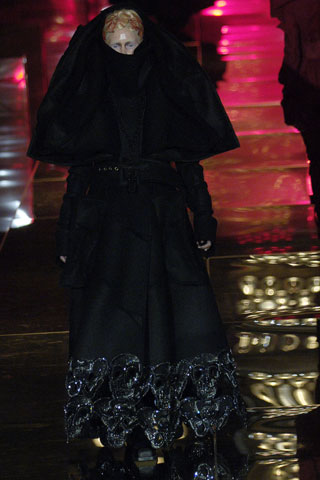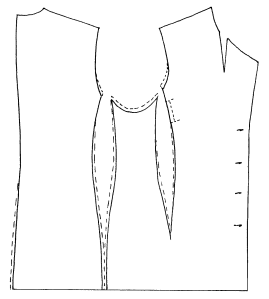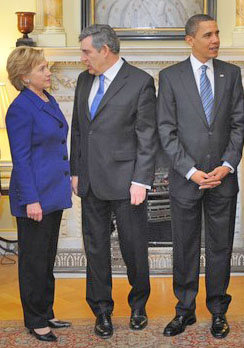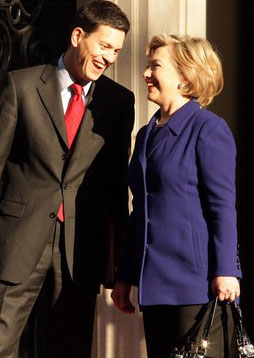Last Friday, Phyllis and Ann had the opportunity to see the Fashion Show, Paris Collections 2006. This show has garnered critical praise from fashion press and fashionistas and, well, criticism from the art critics. It’s a blockbuster regardless of whether you think it belongs in an art museum or not. We went on a Friday afternoon, which is an ideal viewing time. The crowd was moderate, and we were able to get up close and personal with many of the garments.
The Galleries
The exhibit is divided into three conjoined galleries. The first is what we considered “high end ready to wear” looks. Yohji Yamomoto, Viktor & Rolf, Hussein Chalayan and Maison Martin Margiela made up this section of the exhibit. These are designers whose connection to the “old time” haute couture houses is mostly through historical references, as opposed to work experience. The feeling that seemed to unify these collections was fashion as theater. The approach was a more highbrow daywear collection.
Yojhi Yamomoto’s collection was emblematic of this. There were a lot of riffs on the Japanese “look”, combined with tartan punk. Ann’s opinion was that the whole looked rather like a mess, and it just didn’t have the panache of a couture collection. Phyllis thought the hats made it look like it was channeling the Belle Epoque, but seen through a 90s minimalist lens. It’s interesting; we’d love to see what the pattern pieces look like. But it was not something that you would want to wear.
Victor and Rolf:

did some very interesting work with metallic fabrications. It looks like they were using silver leaf that they melted onto linen and cottons. Phyllis noted some “blobs” of silver that had fallen onto the skirts of these heavily crinolined dresses. The underlayers were of particular interest too. In several instances, the designers used double-hoop skirts to support the weight of the garments. The metallic overlays looked almost like solder. The under structure of the dresses was fascinating, but there were also some amazing touches on the outer garments. There was one cotton trenchcoat that had bias-tube encased wires that were woven into a trellis pattern to form the collar and lapel. Another trench had an amazing ruffle held in place by buttons. And if you unbuttoned at the top of the collar, it would create a capelet effect. But we noticed that the garments didn’t travel very well – at least the metal coated ones. There were a lot of stress fractures evident in the dresses.
For both of us, the part of the exhibit that worked least well was the Maison Martin Margiela section. Ann thought it looked too precious, with a beer-bottle-cap vest and playing card jerkin. There was one women’s vest that was kind of cool. It was made from fabric flowers. Phyllis asked, “What was that place we went to in New York, with the hats? Manny’s Millinery?” You could get the same effect with a vintage vest, a raft of flowers from Manny’s and a glue gun. Have at it Martha!
There was one very interesting vest, made from fake pearl necklaces and bracelets. The interesting thing was the boned understructure, which formed a cage around the body. The pearls were balanced so the garment would hang appropriately on the body without pulling in one direction or another. But is it couture? Meh.
The final collection in the first gallery was Rochas/Olivier Thyskens. This was the most ready-to-wear looking of the collections. The workmanship was interesting. There were some touches that were quite theatrical, but in a superficial way. There were lots of collars that looked like padded armrests (great for when you’re taking long plane trips, we’re sure). There were also club-chair nailheads, and one dress with quilted, padded hips that reminded us of the Bumsters Vivienne Westwood did back in the 90s. There was also a “Bird on a Wire” dress that had appliqued silhouettes birds on telephone wires on the chiffon overlayer of a long grey dress. Pretty, but not really “couture”, in Ann’s view. Phyllis thought many garments had that 40’s look of superficial adornment. Contrast that with Valentino’s selections, which are equally elaborate and yet the enbellishment is an integral part of the garment.
The second gallery housed two collections: Azzedine Alaia and John Galliano for Dior.
The Alaia collection was black and white, and accentuated by its use of goat and mongolian lamb. There were several dresses and coats whose major features were long haired goat skins. The skirts were particularly interesting, even if you have to be completely curveless to wear them. There was one gown made of shirred silk ribbons that was fascinating to examine. The shirring ended at the side seams, and it looked like there was a sheer underdress holding the structural bones of the garment. The other amazing thing about this dress was how tine the model must have been! Her waist could not have been any larger than about 21 inches. Give that girl a hamburger.
Dior and Galliano, that Funky Little Fashion Troll

could have been the most disastrous of the bunch. It was punk meets Directoire Period under a blood red sky. But it worked, though it’s something you might have a hard time with at the office. There was one coat that on the runway looked grotesque:

But with the collar down and no makeup, it was a much more wearable look. Well, wearable if you are going to a high gothic celebration of Dante’s Inferno. The coat was amazing to see though. It was a feat of engineering. It was very heavy leather with all sorts of belts and supports. The hem was a cutaway of skulls embellished with crystal nailheads. It was quite breathtaking.
The third and final gallery housed the most classic of the couture collections: Valentino, Chanel and Christian LaCroix. These are the “old timers”, both in terms of approach taken to the couture and in terms of the designers’ longevity in the Chambre Syndicale. The fabrics were precious, the workmanship was exquisite, and the embellishments were obviously thought out as an integral part of the garment, rather than something that looked “slapped on” (see Thyskens, above) after the fact. From a construction standpoint, examining these garments was most rewarding. We were literally looking under the skirts to see how the garments were made, and how the embroidery and embellishment was done. In several of the Chanel garments, the caption said that there was over 900 hours of embroidery. It was awe inspiring, and if you take a look at the underpinnings of the clothes, you can see that it was done after the dress was made.
The Lacroix collection was matador and infanta inspired.

As you would expect from Lacroix, the embroideries were fantastic, the fabrics were breathtaking and the workmanship was, well, Lacroix.
Valentino’s collection was the most red-carpet ready, in Ann’s view. There was an array of gowns, dresses and suits, any of which would look just right at the awards ceremonies. The embellishments on these outfits were just stunning, from cutaway strips of fabric, to crystal pleating, to ribbon embroideries. It was stunning to look at and inspirational in a way that puts “Art to Wear” to shame.

The Crowd
Inexplicably, most of the people at the exhibit on Friday were more interested in the (very low quality) runway videos projected on the walls than they were in the very real couture before their eyes. Phyllis thought this was due to the fact that no one had any idea how to view and evaluate an haute couture collection. The only way it could be real for them was to watch it on a screen, just like Mike Teevee in “Willy Wonka & The Chocolate Factory”. So there we were, the two of us, taking way too loudly, contrasting and comparing garments, disucssing construction details, kneeling down to look under skirts,
and generally getting as close to the garments as possible without setting off the alarms, while everyone else spoke in hushed tones or eavesdropped on our conversation. You can get quite close (within two feet) without setting off an alarm or having a guard come running over to scold you. Not too many people took advantage of it, but we did!
There were a few snippets of conversation that we overheard that were amusing, too.
“Oliver (sic) Theyskens? Oh yeah, he did some dress for Madonna.”
“I’m going to a 70s party. Go go dresses were 70s, weren’t they?”
Gratifyingly, there were quite a number of younger (college and high school) folks there who looked like they were design students.
But Is it Art?
Well, as Andy Warhol says, “Art is a man’s name” so yes – it is art the same way a silk screen of a Campbell’s soup can can be printed onto a paper dress. Fashion is one of the few art forms that is both High and Low, and the best “Low” form of art in the this exhibit was not Margilea’s self conscious garments but rather the Rochas padded hip dresses that looked like one’s grandmothers upholstery – they were only missing lace anti-macassars on those padded collars.
Also, an understanding of the haute couture business model is crucial to appreciating an exhibit like this. Couture is a loss leader whose main function today is to increase branding, promote ready-to-wear and sell licensed products. In the vast majority of cases, the only people who will ever wear these garments are the runway models. This is a fact that gets lost in the shuffle and the hype. In some ways, the couture is the ultimate irony these days. Amazing stuff that goes nowhere after it takes its 20 meter stroll down the catwalk. If the MFA had been running “The Devil Wears Prada” instead of runway films the audience might be better educated.
But as it is, the exhibit is great fun, and if you are interested in construction, you can get a bird’s eye view of garments and techniques that few will apply and fewer will own. By all means, go to this exhibit before it closes.



 Hillary and Michelle are out there this week, highly visible on their charm tour of European capitals.
Hillary and Michelle are out there this week, highly visible on their charm tour of European capitals.


















 Subscribe with Bloglines
Subscribe with Bloglines